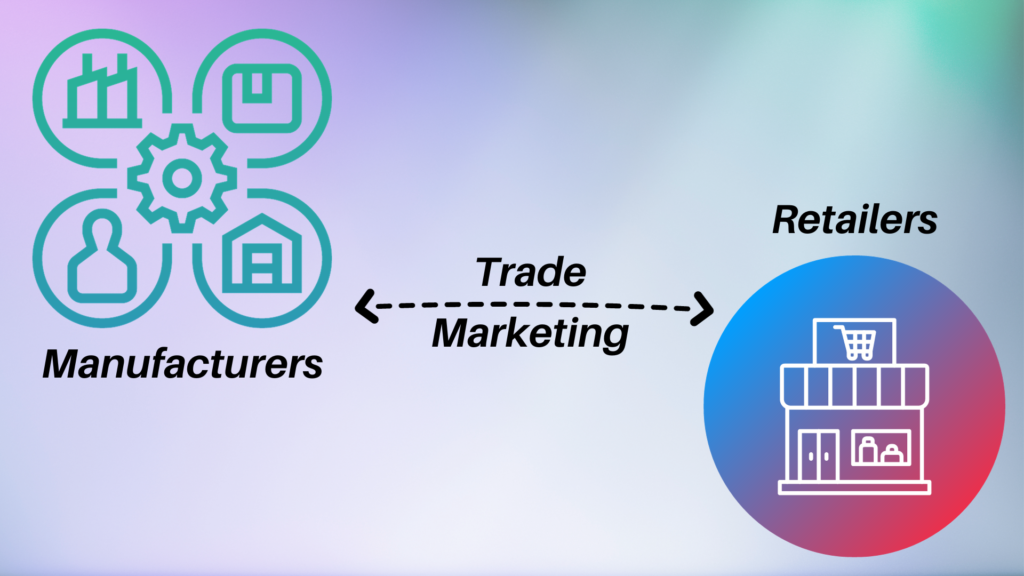B2B marketing is complicated. It’s B2C marketing with extra steps.
Think about it: Instead of simply influencing the end consumer to buy your product/service, in B2B marketing, you (manufacturer/supplier) have to influence a middleman (distributor/retailer) by convincing them that the end consumer will be interested in buying your product/service.
This game of influence (B2B2C ?) is not for the weak and has emerged as a sub-category of B2B marketing known as trade marketing.
Are you up for the challenge? In the following blog, I’ll give you a gist of trade marketing, its significance in the bigger picture of a supply chain, some strategies with an example (that blew my mind!), the role of technology, and the scope of artificial intelligence in the future of the field.
Table of Contents
What is trade marketing?
Promotional activities, efforts, and strategies involved in increasing the demand for products & services among retail and wholesale partners are collectively referred to as trade marketing.
In a simpler sense, it’s the function that convinces other businesses (traders) to purchase (buy) your offering and distribute (sell) it to the end consumer.
For example, Reebok (manufacturer) may offer Walmart (retailer) an extra $100 as a bonus on every $4900 worth of merchandise sold in an attempt to encourage Walmart to (buy) and sell more Reebok products out of their outlets. In response to this, Adidas (manufacturer) may slash their wholesale prices in a strategic attempt to make their business seem more lucrative for Walmart. So on, and so forth…
Significance of trade marketing (Why)
What makes this function of trade marketing so important? What role does it play? To understand this, let’s look at the larger supply chain, i.e., how a product moves through different processes before reaching the end consumer.
Manufacturers source raw materials from various vendors to either create a product from scratch or simply assemble it at the manufacturing unit. Once the products are ready for distribution, they are moved to a storage unit or a warehouse, so that they can go out to wholesalers or retailers in big batches (thus reducing logistical costs).
Now, from this point onwards, until the products reach the shelves of retailers or end distributors, all activities are dependent on the trade marketing function.

Trade marketing plays the role of a middleman between manufacturers and retailers. In this sense, it becomes an inevitable part of the supply chain. The function altogether is responsible for the following important business activities:
(i) Market Research & Analysis
Any business must stay on top of available market opportunities.
Finding lucrative retail outlets, untapped markets, and consumer buying trends that can be leveraged to drive sales can be factors that set manufacturers apart from the competition.
Competitor analysis in itself is a continuous activity that gives the business an edge and also helps in understanding the market landscape.
(ii) Building and Maintaining Partner Relations
Simply identifying opportunities translates to nothing useful. Marketers need to approach these retailers and develop strategic partnerships that amount to business profitability. This may involve several rounds of presentations, persuasion, and negotiations, winning some and losing some.
A critical factor that determines the fate of the partnership is the level to which the marketer can influence the retailer. The retailer should leave the discussion truly believing that the product (or service) is desirable and will bring in revenue. All soft skills are put to the test at this point.
The focus, however, should always be on the bigger picture: enabling the business to scale and achieve its goals.
(iii) Providing Support
Since manufacturers are the ones who put time and effort into the product, they are the specialists. They understand the nuances, nitty gritties, and unique selling properties – which retailers might not necessarily do.
It’s the duty of the marketer to help the retailer sell as many products as possible. This is also a crucial factor in determining the future of the partnership.
Also, in case customers are dissatisfied and causing distress to the retailers, the manufacturers or marketers should step in and take ownership of the situation. This will help develop trust in the partnership on the retailer’s end.
Trade Marketing Strategies (How)
As of now, we’ve spoken about the influence that trade marketing executives need to create in order to be able to sell products to retailers. But the next (obvious) question is: How?
In this section of the blog, I’ll take you through some of the commonly known trade marketing strategies, or should I say, Tricks of the Trade.
(i) Effective Merchandising
Once the merchandise (products) finally reaches the retail environment, it needs to be planned and organized in a way that attracts customer attention, increases brand visibility, and maximizes sales. This management falls under the umbrella of merchandising, and the positive response as a result of effective merchandising will incentivize the retailer to keep the partnership going.
As a manufacturing brand, some ways in which you can contribute towards effective merchandising include:
~ Use visual elements like signage, lighting, and decor to create an appealing in-store environment.
~ Ensure timely supply and restocking of inventory so as to not cause inconvenience for the retailer as well as end consumers.
~ Offer special pricing, discounts, or promotions to drive retail revenue.
A thorough understanding of the target segment and behaviour can do wonders for merchandising as a strategy. Right from copy & visuals to price points – everything can be tailored for different customer segments and result in higher sales conversions.
(ii) Exclusive Partnership Deals
Sometimes in order to pursue a lucrative retail partner, you (as a manufacturer or trade marketer) could negotiate to include an exclusivity clause in the terms of the partnership. That would mean selecting that specific retailer as the sole distributor of your products within a defined market or region.
If an end consumer wishes to purchase your product, the only choice would be to visit your retail partner – thus giving them (retailers) increased footfall and – more importantly – an edge over their competitors.
Therefore, retailers would be incentivised to strike deals with you. This also creates a sense of scarcity, thus increasing demand and persuading consumers to buy your products. (You can read more about the different techniques used to persuade customers in this blog of mine.)
While it may seem counterproductive for a manufacturer to limit its distribution network, the trade-off depends on the scale of revenue that the exclusive retail partner can bring in. So this is a subjective strategy, but could turn out to be very effective.
(iii) Trade Shows
Trade shows are exhibition-like events that provide a platform for businesses (primarily manufacturers) to showcase their products and services to a targeted audience of industry professionals, potential clients, retailers, and partners.
These events offer various advantages and opportunities for businesses. Some are listed below:
~ Networking: Trade shows are generally in-person events that facilitate interactions allowing companies to build relationships and network with potential clients, partners, suppliers, and industry peers. This leads to lasting and meaningful connections.
~ Market Research: Businesses can gather valuable market insights by participating in trade shows. They can gauge customer reactions, gather immediate feedback, and identify emerging trends that can help them fine-tune their market offerings. It’s a great way to reach the end customer and understand their pain points.
Additionally, businesses can analyse their competition directly by observing their booth setups, marketing materials, and product offerings. This competitive intelligence is valuable for refining marketing strategies and offerings.
~ Lead Generation & Sales: Trade shows can effectively help businesses in generating leads. By collecting contact information of interested and potential consumers (like folks who stop by the booth), businesses can create a roster of leads to strategically pursue later on. These leads are likely to result in direct sales.
Especially for companies offering products or services that can be demonstrated and purchased on-site, trade shows can help in driving on-the-spot sales.
There’s another whole sub-category of marketing known as Trade Show Marketing that deals with planning and organizing an effective trade show – one that garners interest, increases visibility, and generates revenue opportunities. Some insights and strategies for trade show marketing are listed below:
~ An eye-catching and inviting booth that reflects your brand identity is one of the most basic necessities of a trade show if you want to attract a crowd. Feel free to add creative and unconventional elements that set your booth apart.
~ By promoting your participation in the trade show beforehand through emails, social media, and other marketing channels, you can attract more (and interested) attendees to your booth.
~ Plan activities and gimmicks that can possibly influence people to gravitate towards your booth. This could be fun games, competitions, and giveaways. It’s best to train booth staff to be knowledgeable, approachable, and well-prepared to answer questions and engage with attendees.

Example of A Trade Marketing Strategy (Balaji Chips, India)
Okay – what have we understood of trade marketing so far? In the simplest of terms – it’s convincing retailers to buy and distribute your products.
In the following example that narrates the story of an FMCG Indian snacks brand – Balaji Chips – we’ll see how the manufacturers created a sense of demand in order to influence retailers to partner with them. In a recent video that went viral, this is what came to light:
Bajali Chips desired to increase the demand for their products in the market. So as a trade marketing strategy, they decided to hire a few salesmen. Well actually, salesmen or not – you decide. They were tasked with a very unique job role.
Their job was to go to local kirana (ration) shops set up in every nook and corner of India, and simply ask for Balaji Chips. That specific brand and no other. Like this, all different permutations and combinations of salesmen visited these stores and enquired about Balaji Chips over the next few months.
In the span of a short time, every store owner was seeking a partnership with Balaji Chips because they were convinced that the brand was in demand amongst their consumer base.
Thus, the trade marketing strategy was successfully executed. There are many creative ways in which you can influence a person – consciously and subconsciously. These may take some time to execute and show results, but will definitely pay off!
The Role Of Tech In Trade Marketing
Several aspects of the trade marketing function involve relationship management, maintaining efficiency, and ensuring high quality of the products (and services). Over the years, technology has evolved to accommodate several challenges that trade marketing executives face while running operations. A brief description of the role of technology has been listed below:
~ Digital Shelf Management: Several tools and software(s) have been introduced that help manage product listings and inventory and ensure accurate, up-to-date information for customers.
~ E-commerce Integration: As online sales and commerce have grown over the last decade, integrating e-commerce platforms into trade marketing strategies has become vital. platforms like Shopify, Magento, or WooCommerce enable convenient creation and management of online stores.
~ Mobile Apps: Apps for retailers that facilitate ordering, inventory management, and accessing marketing materials have made it easier for manufacturers to run their operations.
Technology has also made it possible for manufacturers to personalize their communications and elevate their marketing efforts.
The Modern Tech-Stack Used In Trade Marketing
(i) Customer Relationship Management System
CRM software is probably the most commonly used tech in any sales/marketing function. These are essential for managing and maintaining relationships with retail partners, distributors, and customers. They store contact information, communication history, and other critical data to facilitate effective B2B interactions. Some examples include:
~ Salesforce
~ Monday.com
~ SendPulse
(ii) Data Analytics and Business Intelligence Tools
Data has taken over every function of a business. With the abundance in availability, it’s crucial for any business to gather, store and derive insights from data judicially. Areas like sales, market trends, consumer behaviour, etc. can benefit greatly from data-driven intel. Some platforms that can assist businesses in this include:
~ Tableau
~ Microsoft Power BI
~ Google Analytics
(iii) Inventory Management Software
As mentioned in the previous section, efficient inventory management is vital in trade marketing. These systems help optimize stock levels, track product movements, and ensure on-time product availability. All of these factors contribute to the overall retailer and consumer satisfaction levels. Effecient inventory management also ensures cost-effectiveness. Some examples include:
~ Katana
~ Upserve
~ Zoho
(iv) Trade Promotion Management Software
Otherwise known as TPM, trade promotion software is a specialized category of software solutions designed to plan, execute, and analyze trade promotions and marketing campaigns. These tools help businesses in creating and allocating budgets to specific promotions, monitor spending, optimize strategy, etc. Some examples of TPMs include:
~ SAP TPM
~ Oracle Trade Management
~ Vistex
(v) Retail Execution Software
This software helps businesses monitor and improve their in-store execution, ensuring that products are displayed correctly, shelves are well-stocked, and promotions are implemented as planned. It’s an extension of the merchandising strategy. Some examples include:
~ GoSpotCheck by FORM
~ Accenture Cloud Retail Execution and Trade Promotion Management
~ Relex Solutions
While some challenges like complex supply chains and inaccurate ROI measurement still lurk in the field of trade marketing, technology is evolving at a rapid rate, providing smarter (and smarter) solutions to these obstacles.
As a marketer, you can help in improving the efficiency of the function by closely observing the supply chain and how products/services are promoted and distributed all the way along.
That’s the end of the blog. Let me know your thoughts by dropping in a comment, and I’ll see you next time.
Tiddles out!
Frequently Asked Questions
Define Trade Marketing.
The sub-section of marketing involved in increasing the demand for products & services among retail and wholesale partners is collectively referred to as trade marketing.
What is Trade Show Marketing?
The sub-category of marketing that deals with planning and organizing an effective trade show that garners interest, increases brand visibility and generates opportunities for revenue is known as trade show marketing.
Why is Trade Marketing Important?
Trade marketing plays the role of a middleman between manufacturers and retailers. The function undertakes crucial business activities such as market research and analysis, building and maintaining partner relations and providing support to retailers and distributors.
Trade Marketing v/s Consumer Marketing
Trade marketing primarily targets retailers while consumer marketing targets end consumers. When it comes to the strategies deployed, trade marketing focuses on trade promotions, trade shows, merchandising, and supply chain optimization. On the other hand, consumer marketing focuses on advertising, content marketing, and brand building.

